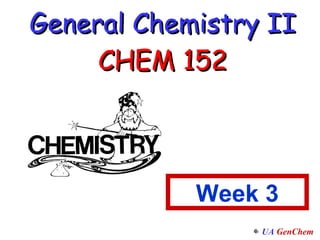
Lect w3 152_d2 - arrhenius and catalysts_alg (1)
- 1. General Chemistry II CHEM 152 Week 3
- 2. Week 3 Reading Assignment Chapter 13 – Sections 13.5 (temperature), 13.7 (catalysts)
- 7. The higher the temperature, the more molecules have energy to overcome the activation energy barrier. Low T High T Extra molecules at high T that exceed the E a Enough Energy
- 13. Reaction Coordinate Diagrams E Reactants E Products ∆ E reaction E activated complex E a Notice E a is not related to ∆E
- 14. Find E a and ∆E in each case. Identify endothermic and exothermic processes. Your Turn
- 15. SOLUTION A key reaction in the upper atmosphere is The E a(fwd) is 19 kJ, and the H rxn ( ∆E) for the reaction is -392 kJ. Draw a reaction energy diagram for this reaction, postulate a transition state, and calculate E a (rev) . Your Turn O 3 ( g ) + O( g ) 2O 2 ( g ) transition state E a = 19kJ H rxn = -392kJ E a (rev) = (392 + 19)kJ = 411kJ
- 16. The Arrhenius Equation ln k = ln A - E a /RT where k is the rate constant at T E a is the activation energy R is the energy gas constant = 8.3145 J/(mol K) T is the Kelvin temperature A is the collision frequency factor Temperature Effects ln k 2 k 1 = E a R - 1 T 2 1 T 1 -
- 17. ln k = -E a /R (1/T) + ln A Graphical Analysis . Y = m X + b
- 18. Typical Problems Suppose a chemical reaction has an activation energy of 76 kJ/mol. By what factor is the rate of reaction at 50 o C increased over its rate at 25 o C? k 2 =rate constant @ 50ºC k 1 =rate const @ 25ºC k 2 /k 1 = 10.7 over 10 times faster! = -76000 J 8.3145 J/mol K ln k 2 k 1 = 2.37 ln k 2 k 1 1 323.15K 1 298.15K -
- 19. The decomposition of hydrogen iodide, E a = ___________ kJ/mol 2HI( g ) H 2 ( g ) + I 2 ( g ) has rate constants of 9.51x10 -9 L/mol*s at 500. K and 1.10x10 -5 L/mol*s at 600. K. Find E a .
- 20. SOLUTION The decomposition of hydrogen iodide, has rate constants of 9.51x10 -9 L/mol*s at 500. K and 1.10x10 -5 L/mol*s at 600. K. Find E a . E a = 1.76 x 10 5 J/mol = 176 kJ/mol Answer / 2HI( g ) H 2 ( g ) + I 2 ( g ) ln k 2 k 1 = E a - R 1 T 2 1 T 1 - ln 1.10x10 -5 L/mol*s 9.51x10 -9 L/mol*s 1 600K 1 500K - E a = - (8.314J/mol*K)
- 21. Series of plots of concentra-tion vs. time Initial rates Reaction orders Rate constant ( k ) and actual rate law Integrated rate law (half-life, t 1/2 ) Rate constant and reaction order Activation energy, E a Plots of concentration vs. time Overview Find k at varied T Determine slope of tangent at t 0 for each plot Compare initial rates when [A] changes and [B] is held constant and vice versa Substitute initial rates, orders, and concentrations into general rate law: rate = k [A] m [B] n Use direct, ln or inverse plot to find order Rearrange to linear form and graph Find k at varied T
- 26. The metal-catalyzed hydrogenation of ethylene
- 27. Catalytic Converters 13.6 CO + Unburned Hydrocarbons + O 2 CO 2 + H 2 O catalytic converter 2NO + 2NO 2 2N 2 + 3O 2 catalytic converter
- 29. Enzyme Catalysis
- 30. Enzymes uncatalyzed enzyme catalyzed
- 31. Enzymes Saturation Effects (substrate = reactant) Denaturization
- 32. Summary Activity: Fireflies flash at a rate that is temperature dependent. At 29 ˚C the average firefly flashes at a rate of 3.3 flashes every 10. seconds. At 23 ˚C the average rate is 2.7 flashes every 10. seconds. Use the Arrhenius equation to determine the activation energy (kJ/mol) for the flashing process.
Notas del editor
- Update for Tro.
- Tier 3
- Tier 1
- Tier 2
- Tier 1.5
- Tier 2